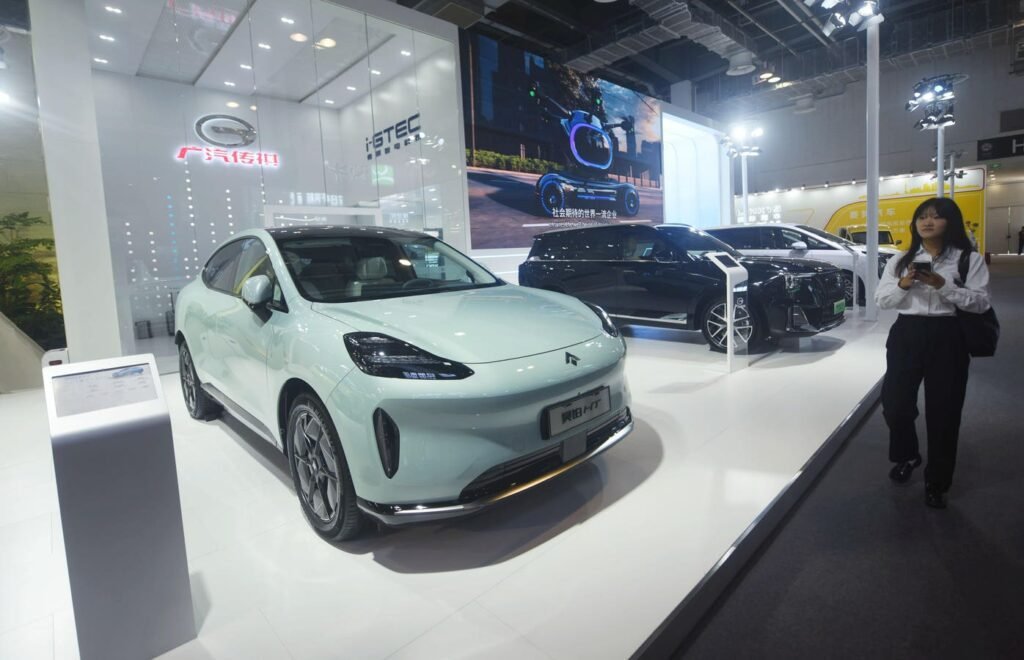SHANGHAI, CHINA – Various GAC Group Electric Vehicles Showcased at Brand China 2024 … [+]
Future Publishing via Getty Images
The global electric vehicle market is hot right now. It could get even hotter as it faces a potential storm with the US and China engaged in a tariff war. The US-China trade honeymoon is over. What was once a one-way street for American exports to China has become a two-way lane, now filled with higher-value Chinese goods headed stateside. This is not what the US intended and recently imposed a heavy 100% tariff on Chinese-made EVs, a move intended to protect domestic automakers (this was part of the White House policy, including lithium batteries and solar cells, along with basic materials such as steel and aluminium). While this sounds like a big deal, the US imports a tiny fraction of its cars from China. The European Union, however, is a major EV consumer market with ambitious green goals and imports the lion’s share of Chinese EVs. It is now considering whether to follow suit with the US and impose its own tariffs.
Meanwhile, China, the world’s biggest producer of electric vehicles, also suggests it could retaliate. What this means for the industry and the consumer is just beginning to surface. However, this seemingly well-intentioned protectionist approach may get local politicians buzzing, but it could have stronger repercussions and unintended consequences for consumers, businesses, and the overall transition to clean transportation.
Europe’s Electric Vehicle Dependence on China: Bargaining Element or Vulnerability?
BERLIN, GERMANY: A sales representative shows prospective customers a BYD Dolphin electric car at a … [+]
Getty Images
China has emerged as the undisputed leader in EV production, exporting over 1.5 million units in 2023 to dozens of markets. The EU is by far China’s biggest EV customer, importing nearly 500,000 vehicles last year – nearly a third of China’s total EV exports. This dominance gives the EU significant leverage in the current geopolitical climate and could also make it vulnerable to escalations.
A full-blown trade war, with the EU mirroring US tariffs, could lead to a significant price increase for European consumers. Unlike the US which imported a fraction (less than 3 percent) of the EU’s total, affordable Chinese EVs, currently a major driver of EV adoption in the region, could become much more expensive. This price increase could affect the EU’s ambitious green mobility policy agenda, which relies heavily on the affordability of electric vehicles to achieve mass market penetration.
Finding the Right Balance: Negotiation and Innovation
French President Emmanuel Macron hosts Xi Jinping for state visit to woo Chinese … [+]
POOL/AFP via Getty Images
The EU faces a complex dilemma. While China’s domestic EV production subsidies warrant more attention, the bloc cannot afford to become a pawn in the US-China trade dispute. Instead, the European Commission is carefully weighing the benefits of affordable Chinese electric vehicles for its agenda against the potential downsides of protective tariffs on its domestic production.
Negotiations with China to address concerns about subsidies and level the playing field present a more strategic approach. Additionally, the EU can leverage its reliance on Chinese EVs as a bargaining chip to push for fairer trade deals that benefit all parties.
Limited impact elsewhere, but Ripple Effects beyond EVs
The impact of tariffs on the global EV market may be exaggerated. It is too early to say what that impact will be. Alternative markets such as Canada and Mexico are likely to absorb some of the Chinese EVs diverted to the US, albeit in relatively small volume compared to EU uptake.
However, the implications extend beyond the automotive industry. Existing tariffs on sectors such as semiconductors, vital to EV production, highlight the potential for wider disruptions to global supply chains. These disruptions could lead to production slowdowns, more bottlenecks and price increases across the board, further hampering the global transition to clean transport.
Tesla, a major player in the electric vehicle space, is not immune to the trade war vibrations. The company sources some battery components from China. Increased tariffs on these parts could increase Tesla’s production costs, potentially leading to higher prices for consumers. In addition, China may retaliate with tariffs on US-made cars, affecting operations at Tesla’s Gigafactory in Shanghai.
Force for Change or Missed Opportunity?
Thousands of BYD electric cars waiting to be loaded onto a ship are seen stacked in the … [+]
AFP via Getty Images
The current situation can be a catalyst for positive change. The US and EU could use this as an opportunity to revamp their domestic electric vehicle industries. Increased investment in clean car technologies, battery production and supply chain resilience could create a more sustainable and self-sufficient EV ecosystem in these regions. Investments are already being made in all three sectors, they just have a lot to cover. It also doesn’t help that the media is constantly adding fuel to the fire with anti-EV sentiment. EVs are inevitable, the hockey stick adoption curve has already turned upward, and most vehicle purchases have exceeded 10% of new sales, if not higher. These measures, combined with the removal of trade barriers, could boost innovation, create more jobs and accelerate the global transition to clean transport.
However, if the trade war escalates, it could stifle innovation and slow the global transition to clean transportation. Policymakers in the US, EU and China have a critical choice to make: Will they prioritize short-term protectionist measures at the expense of the long-term environmental and economic benefits of a clean transport future?

